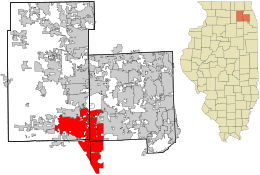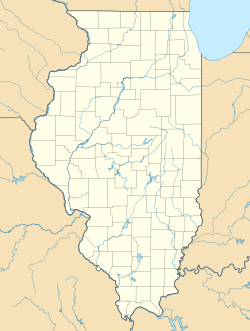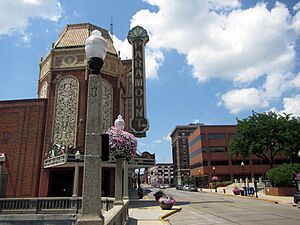Aurora, Illinois facts for kids
Quick facts for kids
Aurora, Illinois
|
|||||
|---|---|---|---|---|---|
|
|
|||||
|
|||||
| Nickname(s):
City of Lights
|
|||||
| Motto(s):
A City Second to None
|
|||||

Location of Aurora in DuPage and Kane Counties, Illinois.
|
|||||
| Country | United States | ||||
| State | Illinois | ||||
| Counties | DuPage, Kane, Kendall, Will | ||||
| Townships | Aurora (Kane), Batavia (Kane), Sugar Grove (Kane), Naperville (DuPage), Winfield (DuPage), Oswego (Kendall), Wheatland (Will) | ||||
| Settled | 1834 | ||||
| Incorporated (village) | 1845 | ||||
| Incorporated (city) | 1857 | ||||
| Founded by | McCarty Brothers | ||||
| Government | |||||
| • Type | Mayor–council | ||||
| Area | |||||
| • Total | 45.91 sq mi (118.91 km2) | ||||
| • Land | 44.97 sq mi (116.47 km2) | ||||
| • Water | 0.94 sq mi (2.45 km2) | ||||
| Elevation | 719 ft (219 m) | ||||
| Population
(2020)
|
|||||
| • Total | 180,542 | ||||
| • Rank | US: 144th | ||||
| • Density | 4,014.81/sq mi (1,550.13/km2) | ||||
| Time zone | UTC−6 (CST) | ||||
| • Summer (DST) | UTC−5 (CDT) | ||||
| ZIP Codes |
60502–60507, 60568, 60569, 60572, 60598
|
||||
| Area codes | 630, 331 | ||||
| FIPS code | 17-03012 | ||||
| GNIS feature ID | 2394031 | ||||
| Demonym | Auroran | ||||
| Wikimedia Commons | Aurora, Illinois | ||||
Aurora is a city in northeastern Illinois, United States. It is located along the Fox River. In 2020, about 180,542 people lived there.
Aurora is the second-largest city in Illinois, after Chicago. It is also one of the largest cities in the U.S. Aurora is special because it's the biggest city in Illinois that isn't the main town (county seat) of any county it's in.
The city was first built in Kane County. But over time, it grew into DuPage, Kendall, and Will counties too. Aurora used to be a city known for making things. Since the 1960s, it has grown a lot and is now a big city near Chicago.
In 1908, Aurora got the nickname "City of Lights." This is because in 1881, it was one of the first cities in the United States to have electric street lights everywhere.
Downtown Aurora is built around Stolp Island. The city has three main parts: the West Side, the East Side, and the Far East Side/Fox Valley. Aurora has some cool buildings designed by famous architects. It's also home to the Hollywood Casino Aurora, a fun place with games located by the river downtown.
Contents
Aurora's Story: A City of Growth

Long ago, before European settlers came, a Native American village stood where downtown Aurora is now. It was on the banks of the Fox River.
In 1834, after the Black Hawk War, the McCarty brothers settled there. They built a mill. Later, they sold land on the west side of the river to the Lake brothers, who also opened a mill. Aurora officially started with a post office in 1837.
Aurora began as two separate villages. East Aurora was on one side of the river and started in 1845. West Aurora was on the other side and began in 1854. In 1857, the two villages joined together to become the city of Aurora. They decided to build most public buildings on Stolp Island, in the middle of the river, because they couldn't agree on which side should have them.
As Aurora grew, many factories and jobs came to the city. In 1849, a railroad was built to connect Aurora to other areas. This railroad later became the Chicago, Burlington and Quincy Railroad. This company built its main repair shops in Aurora. It became the city's biggest employer until the 1960s.
Many immigrants from Europe came to Aurora for jobs in these factories. They came from places like Ireland, Germany, and Italy. Aurora became an important economic center for the Fox Valley region. The city was also very open-minded for its time. It supported ending slavery before the American Civil War. In 1851, it created the first free public school district in Illinois. It even had a high school for girls in 1855.
In 1909, a strong earthquake hit Aurora. It was one of the biggest earthquakes ever in Illinois.
Aurora was a strong manufacturing city until the early 1970s. Then, many factories closed or moved away. By 1980, there were not many factories left, and many people lost their jobs.
In the late 1970s and early 1980s, new areas of the city began to grow further east. This helped the city financially. However, it also meant fewer businesses stayed downtown.
In 1993, the Hollywood Casino opened downtown. This helped bring new life and development back to the downtown area. In the late 1990s, more new homes and neighborhoods were built around the city. This caused Aurora's population to grow a lot.
2014 Air Traffic Control Fire
On September 26, 2014, a fire happened at an air traffic control building in Aurora. This building is also called the "Chicago Center." The fire caused almost 2000 airline flights to be stopped.
Where is Aurora?
Aurora is located at coordinates 41.7637855 degrees North and -88.2901352 degrees West.
The city covers about 45.91 square miles (118.91 square kilometers). Most of this area is land, and a small part is water.
Aurora is mainly in Kane County. But it also reaches into parts of DuPage, Kendall, and Will counties. Aurora is one of only three cities in Illinois that are in four counties!
Parts of Aurora
The city is divided into 10 political areas called wards. Aurora has three main regions:
- The West Side: This is the area west of the Fox River.
- The East Side: This area is east of the Fox River, up to the DuPage County line.
- The Far East Side: This part of Aurora is east of the DuPage County line.
These regions help organize police and school districts.
Aurora's Weather
Aurora gets about 40 inches of rain or snow each year. The hottest day ever recorded in Aurora was 111°F (44°C) on July 14, 1936. The coldest day was -31°F (-35°C) on January 16, 2009. In July, the average high temperature is about 84°F (29°C). In January, the average low temperature is about 13°F (-11°C).
In July 1996, a very big flood hit Aurora. It rained 16.94 inches (430 mm) in just 24 hours. This was a record for Illinois. Many low areas in the city flooded, and the Fox River overflowed in some neighborhoods.
In 1990, a strong thunderstorm passed over Aurora. It dropped hail the size of golf balls and caused wind damage. Less than ten minutes later, this storm created a powerful tornado. This tornado touched down near Oswego, which is close to Aurora. It then traveled through Plainfield and Joliet, causing many deaths.
People of Aurora
| Historical population | |||
|---|---|---|---|
| Census | Pop. | %± | |
| 1850 | 1,200 | — | |
| 1860 | 6,011 | 400.9% | |
| 1870 | 11,162 | 85.7% | |
| 1880 | 11,873 | 6.4% | |
| 1890 | 19,688 | 65.8% | |
| 1900 | 24,147 | 22.6% | |
| 1910 | 29,800 | 23.4% | |
| 1920 | 36,300 | 21.8% | |
| 1930 | 46,589 | 28.3% | |
| 1940 | 47,200 | 1.3% | |
| 1950 | 50,600 | 7.2% | |
| 1960 | 63,715 | 25.9% | |
| 1970 | 74,200 | 16.5% | |
| 1980 | 81,293 | 9.6% | |
| 1990 | 99,581 | 22.5% | |
| 2000 | 142,990 | 43.6% | |
| 2010 | 197,899 | 38.4% | |
| 2020 | 180,542 | −8.8% | |
| U.S. Decennial Census 2010 2020 |
|||
In 2020, Aurora had 180,542 people living in it. There were 65,128 households. About 43.6% of these households had children under 18 living with them.
The average age of people in Aurora was 34.4 years old. For every 100 females, there were about 98.7 males.
Aurora's Economy
Aurora is located near the Illinois Technology and Research Corridor. The city has a long history of making things, like many other places in the Chicago area. Some well-known companies that have been in Aurora include Caterpillar Inc. and Western Electric. The biggest employer for a long time was the Chicago Burlington and Quincy Railroad.
Top Employers in Aurora
Here are some of the largest employers in Aurora:
| # | Employer | # of Employees |
|---|---|---|
| 1 | Rush Copley Medical Center | 2,200 |
| 2 | West Aurora Public School District 129 | 1,650 |
| 3 | East Aurora Public School District 131 | 1,320 |
| 4 | Amita Health Mercy Medical Center | 1,300 |
| 5 | City of Aurora | 1,280 |
| 6 | Dreyer Medical Clinic | 1,200 |
| 7 | Indian Prairie School District 204 | 1,200 |
| 8 | Caterpillar Inc. | 1,100 |
| 9 | Hollywood Casino Aurora | 1,010 |
| 10 | MetLife, Inc. | 800 |
Visiting Aurora
The Aurora Area Convention and Visitors Bureau helps promote the area. Their goal is to bring more visitors to Aurora and nearby towns. These towns include Batavia, Montgomery, North Aurora, Oswego, and Yorkville.
Arts and Fun in Aurora
Downtown Aurora has the Paramount Theatre. This is a large theater for live shows and is a historic building. The Hollywood Casino is also downtown.
The Leland Tower is another important building. It used to be a hotel and was the tallest building in Illinois outside of Chicago. It is also a historic place.
The Riverfront Playhouse is a theater group that has been in downtown Aurora since 1978.
A campus of Waubonsee Community College used to be on Stolp Island. In 2011, a new, much bigger campus was built on the west side of the river. This was part of a plan to make downtown more inviting with parks and walking paths. A pedestrian bridge was also built to connect the river banks.
Museums in Aurora

- Aurora Historical Society
- Aurora Regional Fire Museum
- The Aurora Public Arts Commission
- Grand Army of the Republic Hall
- Phillips Park Zoo
- David L. Pierce Art and History Center
- Schingoethe Museum of Native American Culture (focuses on Native American culture)
Sports and Recreation
The Stonebridge Country Club in Aurora has hosted big golf tournaments. These include the LPGA Tour's Kellogg-Keebler Classic and the Senior PGA Tour's Ameritech Senior Open.
Aurora used to have a minor league baseball team called the Aurora Islanders/Blues/Foxes from 1910 to 1915. A very famous player, Casey Stengel, played for them in 1911. He was a great hitter and stole many bases. He later became a well-known baseball manager.
Aurora University has many sports teams that compete in NCAA Division III.
Aurora also has its own zoo, Phillips Park Zoo, which is inside Phillips Park.
Learning in Aurora
Aurora is home to Aurora University. It also has two campuses of Waubonsee Community College and a campus of Rasmussen College. Many Aurora residents go on to higher education.
Public Schools
Since the 1860s, Aurora has had two main school systems. One was on the west side of the Fox River, and the other was on the east side. Later, a third district, Indian Prairie School District (IPSD) 204, was formed in 1972 for the far eastern part of Aurora. All three of these main school districts have their offices in Aurora.
Because Aurora is a large city, some students in different parts of the city attend schools in nearby towns. For example, some students in the far north go to Batavia schools. Some in the far southwest go to Kaneland schools. And some students in the far south go to Oswego schools.
The Illinois Mathematics and Science Academy (IMSA) is a special public school for talented students in grades 10 to 12. Any Illinois student who meets the requirements can apply to attend IMSA for free.
| District | Number of Schools |
|---|---|
| East Aurora School District 131 | 17 |
| West Aurora School District District 129 | 13 |
| Indian Prairie School District 204 | 11 |
| Oswego District #308 | 4 |
| Illinois Mathematics and Science Academy | 1 |
Private Schools
Aurora also has private schools. There are three Roman Catholic High Schools: Aurora Central Catholic, Rosary, and Marmion Academy. There are also seven Catholic elementary schools. Other private schools include Aurora Christian High School and Elementary School, and Resurrection Lutheran School. Fox Valley Montessori School, one of the first Montessori schools in Illinois, is also in Aurora.
Aurora Public Library
The Aurora Public Library has a main library, two smaller branches, and a bookmobile. The main library, called the Santori Public Library, opened in 2015. It has cool features like a 3D printer and a digital media lab, along with many books and other media.
Media in Aurora
Besides Chicago stations, some TV and radio stations are licensed to Aurora.
Television
- WXFT-DT – Channel 60, UniMás network
- WPVN-CD – Channel 24, various networks
- Aurora Community TV (ACTV) – Local cable channel 10
- Total Living Network (TLN) – Regional religious cable channel
- Waubonsee Community College Educational Television – Local cable channel 99
Radio
- WBIG (AM) 1280 AM – Serves Aurora and western suburbs
- WERV-FM 95.9 FM – Serves Aurora and western suburbs
- WLEY-FM 107.9 FM – Serves the entire market
Newspapers
The Beacon-News is Aurora's oldest business, first published in 1846. It is known as one of the best daily newspapers in Illinois.
Getting Around Aurora
Aurora has always been an important place for transportation. The city's transportation system helps people get to nearby towns and cities. Major roads like Interstate 88 and Illinois Route 59 make it easy to drive here. Aurora also has public transportation options. These include two Metra train stops, Pace Bus services, and growing bike paths.
Trains
Aurora is the last stop on the Burlington Northern Santa Fe line of the Metra commuter rail system. This train line takes people into Chicago. The city also has a stop at the Rt. 59 station. This station is on the border with Naperville. The BNSF Railway also has a large train yard in Aurora called Eola Yard.
Buses
Pace Suburban Bus runs local bus service in Aurora six days a week. It connects Aurora to cities like Naperville, Geneva, and Oswego. Pace Bus has 6 bus connections at the Aurora Transportation Center. Aurora also has Pace On Demand service zones. These allow riders to book a trip anywhere within the zone.
Air Travel
The Aurora Municipal Airport is for general aviation. It is just outside Aurora in Sugar Grove. The City of Aurora owns and runs this airport. It helps take some air traffic away from Chicago's bigger airports, O'Hare and Midway. It can even handle large planes like the Boeing 757. Also, the Federal Aviation Administration's (FAA) main air traffic control center for Chicago is on Aurora's west side.
Biking in Aurora
Aurora wants to be a city that is friendly to bicycles. It encourages biking throughout the city. In 2020, Aurora started a Fox Valley Bike Share program. The city has also improved its bike paths and lanes. A new bridge over the Fox River was finished in 2021. This bridge gives bikers and walkers a safe way to get from the Aurora Transportation Center to the Fox River Trail.
Major Roads
- Interstate 88
- US 30
- US 34
- Route 25
- Route 31
- Route 56
- Route 59
- Route 110
- Randall Road
- Orchard Road
Healthcare in Aurora
Aurora has two hospitals. One is Ascension Mercy Medical Center on the west side. The other is Rush–Copley Medical Center in Fox Valley.
Famous People from Aurora
Sister Cities
 Iguala, Mexico (since 2007)
Iguala, Mexico (since 2007)
Images for kids
See also
 In Spanish: Aurora (Illinois) para niños
In Spanish: Aurora (Illinois) para niños































